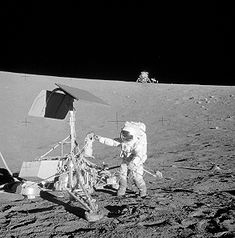
Reports of Streptococcus mitis on the moon
Encyclopedia

Apollo 12
Apollo 12 was the sixth manned flight in the American Apollo program and the second to land on the Moon . It was launched on November 14, 1969 from the Kennedy Space Center, Florida, four months after Apollo 11. Mission commander Charles "Pete" Conrad and Lunar Module Pilot Alan L...
mission, the camera from the Surveyor 3
Surveyor 3
Surveyor 3 was the third lander of the American unmanned Surveyor program sent to explore the surface of the Moon. Launched on April 17, 1967, Surveyor 3 landed on April 20, 1967 at the Mare Cognitum portion of the Oceanus Procellarum...
probe was brought back to Earth. On analyzing the camera it was found that the common bacterium Streptococcus mitis
Streptococcus mitis
Streptococcus mitis is a mesophilic alpha-hemolytic species of Streptococcus that inhabits the human mouth. It is a Gram positive, coccus, facultative anaerobe and catalase negative. It can cause endocarditis...
was alive on the camera. This was attributed by NASA to the camera not being sterilized on Earth prior to its launch two and a half years previously.
Since then, there has been at least one independent investigation into the validity of the NASA claim. Leonard D. Jaffe, a Surveyor program
Surveyor program
The Surveyor Program was a NASA program that, from 1966 through 1968, sent seven robotic spacecraft to the surface of the Moon. Its primary goal was to demonstrate the feasibility of soft landings on the Moon...
scientist and custodian of the Surveyor 3 parts brought back from the Moon, stated in a letter to the Planetary Society
Planetary Society
The Planetary Society is a large, publicly supported, non-government and non-profit organization that has many research projects related to astronomy...
that a member of his staff reported that a "breach of sterile procedure" took place at just the right time to produce a false positive result. One of the implements being used to scrape samples off the Surveyor parts was laid down on a non-sterile laboratory bench, and then was used to collect surface samples for culturing. Jaffe wrote, "It is, therefore, quite possible that the microorganisms were transferred to the camera after its return to Earth, and that they had never been to the Moon." In 2007, NASA
NASA
The National Aeronautics and Space Administration is the agency of the United States government that is responsible for the nation's civilian space program and for aeronautics and aerospace research...
funded an archival study that sought the film of the camera-body microbial sampling, to confirm the report of a breach in sterile technique.
The bacterial test is now non-repeatable because the parts were subsequently taken out of quarantine and fully re-exposed to terrestrial conditions (the Surveyor 3 camera is now on display in the Smithsonian Air and Space Museum in Washington, D.C.
Washington, D.C.
Washington, D.C., formally the District of Columbia and commonly referred to as Washington, "the District", or simply D.C., is the capital of the United States. On July 16, 1790, the United States Congress approved the creation of a permanent national capital as permitted by the U.S. Constitution....
).
The Surveyor 3 camera was returned from the Moon in a nylon duffel bag
Duffel bag
A duffel bag is a large cylindrical bag made of cloth with a drawstring closure at the top....
, and was not in the type of sealed airtight metal container used to return lunar samples in the early Apollo missions. It is therefore possible that it was contaminated by the astronauts and the environment in the Apollo 12 capsule itself.
In March 2011, three researchers co-authored a paper, entitled "A Microbe on the Moon? Surveyor III and Lessons Learned for Future Sample Return Missions" that assessed the validity of claims that the S. mitis samples found on the camera had indeed survived for nearly three years on the Moon. The paper concluded that the presence of microbes could more likely be attributed to poor clean room conditions rather than the survival of bacteria for three years in the harsh moon environment. The paper also discussed the implication this incident would have for contamination control in future space missions.
This subject was covered in the 2008 Discovery Channel documentary series, When We Left Earth.
External links
- http://astrobiology.arc.nasa.gov/news/expandnews.cfm?id=10180
- http://www.lpi.usra.edu/expmoon/Apollo12/A12_Experiments_III.html
- http://news.yahoo.com/s/space/20110506/sc_space/moonmicrobemysteryfinallysolved

